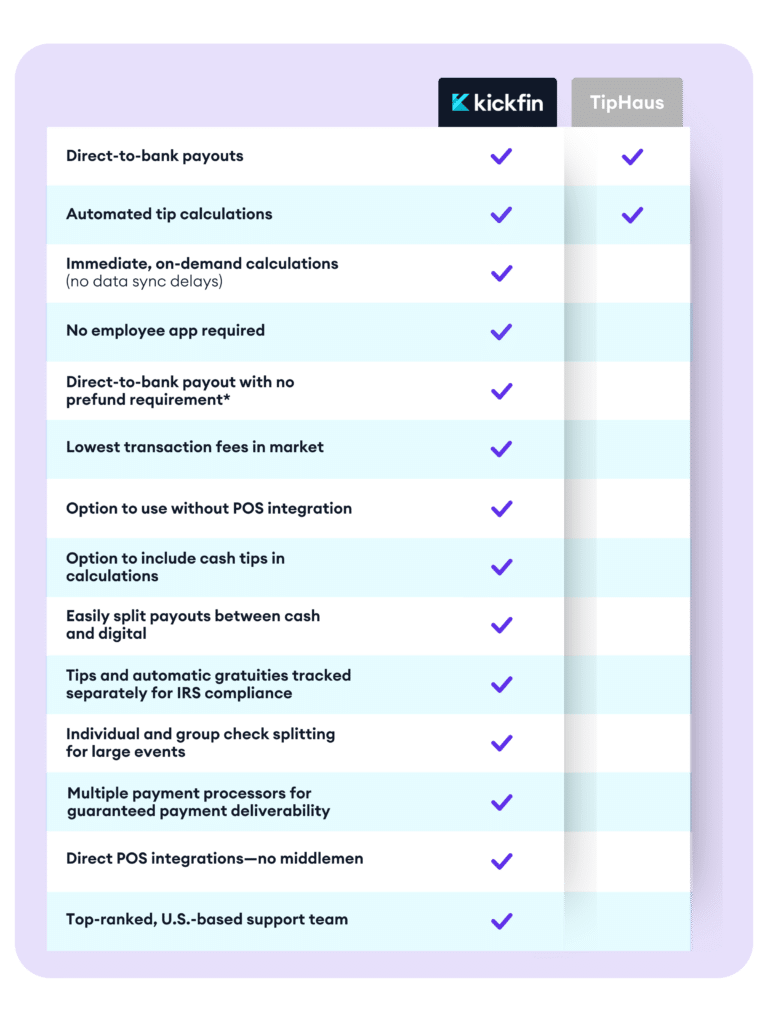Tipping could be considered the ultimate win-win for restaurant teams. Not only do tips significantly increase the earning potential of restaurant employees; in states that allow the tip credit, tips can also help offset labor costs for employers.
While the tip credit can be a boon to a restaurant’s bottom line, calculating the tip credit can make payroll a little trickier.
While most business owners can simply multiply their staff’s hourly wage by their hours worked, restaurant owners who want to take advantage of the tip credit will need to take a few extra steps to determine how much they need to pay their employees on payday.
The downside? A little bit of math. But don’t worry — we can help you out with that part. Here’s what you need to know in order to calculate the tip credit.
First things first: Does the tip credit exist in your state?
Before you start running the numbers, you need to make sure the tip credit is legal where you operate. Tipping regulations vary pretty widely state by state — and the tip credit is no exception.
In a few states, you must pay the full minimum wage, even for tipped employees. At the time of publication, those states are:
- Alaska
- California
- Minnesota
- Montana
- Nevada
- Oregon
- Washington
(If you operate restaurants in one of these states, we’ve got another post on tip calculations that might be helpful to you)
If your state isn’t listed above, then the tip credit is probably allowed in your state. Read on to ensure you’re calculating the tip credit accurately and legally. (And please keep in mind — this post isn’t intended to be legal guidance. Always contact a lawyer with specific questions to ensure your restaurant is compliant with state and federal tipping regulations.)
How does the tip credit work?
With the federal minimum wage still set at $7.25 an hour, employees are required to make at least that much while working at your restaurant — but that’s not how much you have to pay them. Based on the federal tipped minimum wage requirements, you could take a tip credit of up to $5.12 an hour.
How do you calculate the tip credit?
(Keep in mind: these steps are based on federal laws. Your state may have additional or different regulations that apply to your restaurant — so again, consult a lawyer if you have questions.)
1. Keep meticulous records
One of the key tenets of taking the tip credit: making sure employees earn at least minimum wage on an hourly basis. But in order to do that calculation, you’re going to need detailed records that include hours worked, tips earned, and any tips shared with other employees. This will all come in handy when it’s time to process payroll.
2. Grab your calculator
When payroll time arrives, it’s time to revisit some of those multiplication tables that you thought you left in grade school.
As an example, let’s calculate payroll for a part-time server who worked 40 hours during the two week pay period, and earned $250 in tips.
- How much she must earn by federal minimum wage standards: 40 hours x $7.25 = $290
- How much can you take in tip credit: 40 hours x $5.12 = $204.8
- How much she earned in cash wages: 40 hours x $2.13 = $85.2
Now, we’ll use all of these calculations to see if she earned enough to meet minimum wage:
$250 tips + $85.20 hourly = $335.20 total
Since this server earned well over the minimum wage, you can claim the full tip credit of $204.80.
But what if she had come up short?
If the same server worked the same hours but only earned $200 in tips, she would have earned $285.20 — a little short of minimum wage. You’ll need to make up the $4.80 difference in that situation.
How do you calculate the tip credit when paying overtime?
While most restaurants try to avoid paying overtime, short-staffed restaurants may not have an option. If you do pay overtime, here’s how it works when also calculating the tip credit. For example, let’s say that a server worked 50 hours and earned $300 in tips.
- $7.25 minimum wage x 1.5 = $10.88
- Maximum tip credit remains $5.12/hour
- Overtime hourly tipped wage = $5.76
Now, let’s do some math:
- How much must she earn in overtime minimum wage: 10 hours x $10.88 = $108.80
- Add her regular hourly minimum to the overtime minimum: $108.80 + $290 = $398.80
- Tip credit minimum wage: 10 hours x $5.76 = $57.76
- Maximum tip credit: 50 hours x $5.12 = $256
Finally, you can add tips, regular tipped minimum wage, and overtime tipped minimum wage to see if she earned at least $398.80:
$300 in tips + $85.20 regular hourly wage + $57.76 overtime minimum wage = $442.96
Even with overtime, this server still made enough for you to claim the maximum tip credit of $256. Again, if she hadn’t, you would have to make up the difference.
Additional tip credit resources
- Tip Regulations Under the FLSA
- Washington D.C. Eliminates the Tip Credit
- Minimum Wage Laws by State
- What is the Tip Credit and How Does It Affect Me?
Simplify employee payments with Kickfin!
Kickfin makes it easy to pay out your tipped employees — no calculator (or cash) required. Request a demo today and see our cashless tipping software in action!






